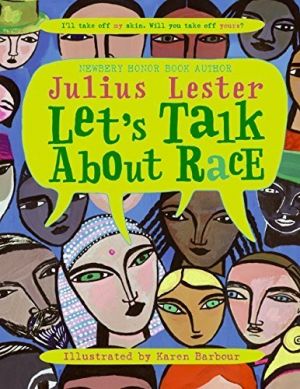Let's Talk About Race
Let’s Talk About Race is children book released in 2005, written by Julius Lester and illustrated by Karen Barbour. Julius Lester is known for a body of work focused on African-American culture, history, and folklore, as well as for his fierce advocacy for books for black children by black creators. In this book, Lester shares his own story and discusses how each individual’s story contains many different elements. In addition, Lester reminds us that there are often more commonalities than differences among people.[1]
Plot
Lester addresses readers as if he is speaking to each in private conversation. He explains about his belief that each person being "is a story" and, by appealingly poking fun at himself, he starts to tell his own story: "I was born on January 27, 1939... (I'm kind of old, huh?)." He told a bit about his family, his favorite food, hobbies, religion, etc. "Oh," he pauses. "There's something else that is part of my story. I'm black. What race are you?" he asks readers, tapping into the nerves in such a discussion. "Because people feel bad about themselves," Lester says, people sometimes thought, "My race is better than your race ." But this isn't correct, the author states simply. If we take our skin off—here Barbour (Fire! Fire! Hurry! Hurry! ) paints a folk-style tableau of skeletons with cheerful smiles and arms upraised—"I would look just like you, and you would look just like me."[2]
Anti-racism value
Let's Talk About Race talks an opportunity for philosophical discussion about race and how racial identity changed the way we see one another. While thinking about their own lives stories and hearing those of their friends, children may begin to find out that what looks like an easy question may not have such an easy answer. This will encourage them to break down their own opinion about race and critically think about them.[3] It helps them become more compassionate toward people and allows them to help push the lever toward true equality. In fact, this books helps children to understand the superficial outward differences and look deeper for general interests, similar likes and dislikes, values, beliefs, and attitudes. We all have a story to explain.[4]
References
- ↑ Reading with Be’chol Lashon: Let’s Talk About Race. Retrieved on January 1, 2021.
- ↑ Let's talk about race. Retrieved on January 1 , 2021.
- ↑ Let's Talk About Race. Retrieved on January 1, 2021.
- ↑ Let's talk about race: The must-read picture book for talking to your kids about race. Retrieved on January1, 2021.
